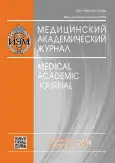IMPACT OF RONCOLEUKIN (RIL-2) ON THE LYMPHOCYTE-TRIGGERING ACTIVITY OF MACROPHAGES AFTER TRAUMATIC BRAIN INJURY IN VARIOUSLY AGED RATS
- Authors: Shanin SN1, Serebryanaya NB1,2,3, Filatenkova TA1, Fomicheva EE1
-
Affiliations:
- Institute of Experimental Medicine, Saint Petersburg
- Saint Petersburg State University, Saint Petersburg
- orth-Western State Medical University named after I.I. Mechnikov, Saint Petersburg, Russia
- Issue: Vol 19, No 1S (2019)
- Pages: 107-108
- Section: Articles
- Published: 15.12.2019
- URL: https://journals.eco-vector.com/MAJ/article/view/19351
- ID: 19351
Cite item
Abstract
IL-1β is involved in both brain damage process and the mechanisms of brain regeneration processes. The goal of the present research is to measure the change in the production of lymphocyte-activating factor (LAF) after experimental traumatic injury (TBI) in variously aged rats and evaluate the possibility to correct LAF production with roncoleukin (rIL-2). LAF activity in the supernatants of peritoneal macrophages of injured rats was measured by its ability to have comitogenic effect on the proliferation of rat thymocytes stimulated by suboptimal lectin doses. LAF stimulation index was defined as ratio of stimulated to unstimulated levels of LTF. Results and discussion. The strongest suppression of microphages’ cytokine-producing function was found in older rats after TBI. rIL-2 injection significantly reversed the injuries caused by TBI even in older rats. These data confirm that exogenic IL-2 is able to activate the functional characteristics of innate immunity cells and that is has a normalizing effect on the immune cells of the older animals.
Full Text
About the authors
S N Shanin
Institute of Experimental Medicine, Saint Petersburg
N B Serebryanaya
Institute of Experimental Medicine, Saint Petersburg; Saint Petersburg State University, Saint Petersburg; orth-Western State Medical University named after I.I. Mechnikov, Saint Petersburg, Russia
T A Filatenkova
Institute of Experimental Medicine, Saint Petersburg
E E Fomicheva
Institute of Experimental Medicine, Saint Petersburg
References
- Dinarello CA. Immunological and inflammatory functions of the interleukin-1 family. Annu. Rev. Immunol. 2009;27:519-550.
- Rybakina EG, Shanin SN, Korneva EA. Cellular, Molecular and Signaling Mechanisms in Neuro-Immune Interactions Under Stress. Advances in Neuroimmune Biology. 2012;3(3-4):235-241.
- Rosenwasser LJ, Dinarello CA. Ability of human leukocytic pyrogen to enhance phytohemagglutinin induced murine thymocyte proliferation. Cell Immunol. 1981;63(1):134-142.
- Higashimoto Y, Fukuchi Y, Shimada Y, et al. The effects of aging on the function of alveolar macrophages in mice. Mech. Ageing Dev. 1993;69:207-217.
Supplementary files







